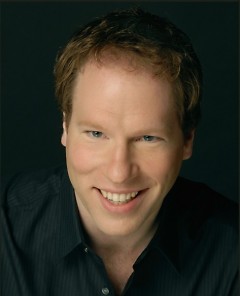If you’ve never set foot in a concert hall, never heard a live, symphony orchestra performance, and have no clue who Carl Orff is, it’s still likely you’re familiar with some of his best work.
If you’ve seen “Cheaper By the Dozen,” “Natural Born Killers,” “Excalibur,” or any number of TV commercials featuring a big chorus of singers chanting in Latin, accompanied by a full-scale orchestra with driving percussion, you’ve likely heard “O Fortuna,” the opening chorus of Carl Orff’s “Carmina Burana.”
Scott Emelander, formerly a member of Grand Valley State University Arts Chorale, discovered it for himself at a rehearsal when the GVSU Arts Chorale appeared with the Grand Rapids Symphony for a performance of “Carmina Burana” in 2007.
“Wait a minute,” Emelander told The Grand Rapids Press. “That’s from the movie, ‘Jackass.’”
Indeed, it is.
“Carmina Burana” closes the Grand Rapids Symphony’s 2015-16 season with a big blowout performance on Friday and Saturday, May 13-14, in DeVos Performance Hall.
Pianist Kirill Gerstein, the 2010 Gilmore Artist of Kalamazoo’s Irving S. Gilmore International Keyboard Festival, returns as guest soloist in Leonard Bernstein’s Symphony No. 2, “The Age of Anxiety,” to open both concerts.
GRS Music Advisor Larry Rachleff leads the performances with guest soloists, the Grand Rapids Symphony, and the Grand Rapids Symphony Chorus and Youth Chorus, all totaling some 200 musicians on stage for Orff’s cantata, which lasts a little less than one hour.
“It’s a huge orchestra, a huge chorus, lots of power on stage” said tenor Brad Diamond, a soloist in the Grand Rapids Symphony’s last performance of "Carmina Burana" in November 2010.
“Carmina Burana,” or “Songs of Buren,” is a collection of songs and choruses, all lusty poems from the 13th century, celebrating the pleasures of love, gluttony and drinking.
The texts in Latin, early French and early German, written by defrocked monks and minstrels, were discovered in the early 20th century. Orff, a German composer and educator, set the texts to music that sounds medieval and modern at the same time.
Eminent conductor Marin Alsop, music director of the Baltimore Symphony Orchestra, describes it as “a spectacle.”
It's very hard to categorize, and that was Orff's the intent, really,” Alsop said in an interview with National Public Radio in 2006. “He wanted it to be a piece for all of the senses: to hear the voice, to hear the words, to experience this enormous orchestra, two pianos.”
“And also, it was envisioned to have a dance element and a theater element as well,” Alsop added.
Though Orff intended it to be staged in a performance sometimes worthy of a PG-13 rating, performances of the popular work usually are given in concert settings.
Translations of the texts about on the joys of feasting, drinking, gambling and wenching, sung in Latin, with a bit of middle-period High German and Old Provencal from the south of France, generally are toned down.
“The music isn’t hard by itself, but it’s a lot of Latin and French and German to get through,” said Pearl Shangkuan, a professor of music at Calvin College, who is in her 12 season as director of the Grand Rapids Symphony Chorus.
“But it’s always fun,” she said. “It’s just a great work.”
The Grand Rapids Symphony has performed the crowd-pleasing cantata three times in the past 15 years, in 2000 and in 2007 as well as in 2010.
“Along with the Beethoven Ninth, this is the most popular crossover piece,” said Shangkuan, prior to the performances in March 2007. “There’s something in it for people with wide ranging taste.”
Vocal soloists this week are soprano Andriana Chuchman, tenor Donald George and baritone Hugh Russell, singing a work that’s taxing for the three, all of whom have to sing above and beyond standard range for their voices.
Diamond, who sang with the Grand Rapids Symphony’s performance in 2010, told the Grand Rapids Press you have to be “in perfect voice to sing it.”
“You just turn it on and hope it comes out,” he said with a laugh.
The Rapidian, a program of the 501(c)3 nonprofit Community Media Center, relies on the community’s support to help cover the cost of training reporters and publishing content.
We need your help.
If each of our readers and content creators who values this community platform help support its creation and maintenance, The Rapidian can continue to educate and facilitate a conversation around issues for years to come.
Please support The Rapidian and make a contribution today.


